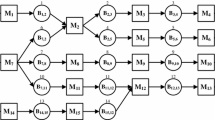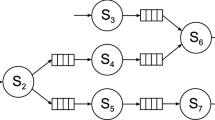Abstract
In this paper, multi-stage assembly/disassembly (A/D) queueing networks are analyzed. We consider finite buffer capacities between the stations, generally distributed service times, and synchronization constraints at assembly and disassembly stations. We then describe a decomposition approach for the performance evaluation of such an (A/D) system, especially for the throughput and the variance of the inter-departure times. The two-station subsystems are analyzed as G/G/1/N stopped-arrival queueing systems. The virtual arrival and service rates, and the coefficients of variation are determined using a heuristic approach. A system of decomposition equations which is solved iteratively is presented. Any solution to this system of equations indicates estimated values for the subsystems’ unknown parameters. The quality of the presented approximation procedure is tested against the results of various simulation experiments.
Scope and purpose
We consider A/D queueing networks with blocking. Our paper extends the work of Manitz (Comput Oper Res 35:2520–2536, 2008) by considering disassembly operations. In addition to that, we give the variability measures of the output process at every station. By considering general service times, it generalizes the work of Gershwin and Burman (Ann Oper Res 93:91–115, 2000). Station failures can be incorporated with the completion-time concept proposed by Gaver (J R Stat Soc 24:73–90, 1962). A comparison to various simulation results shows that the queueing-model based approach presented in this paper yields very good approximations of performance measures.






Similar content being viewed by others
References
Altıok, T. M. (1997). Performance analysis of manufacturing systems., Springer series in operations research New York: Springer.
Altıok, T. M., & Ranjan, R. (1989). Analysis of production lines with general service times and finite buffers: A two-node decomposition approach. Engineering Cost and Production Economics, 17, 155–156.
Balsamo, S., de Nitto Personé, V., & Inverardi, P. (2003). A review on queueing network models with finite capacities queues for software architectures performance prediction. Performance Evaluation, 51(2–4), 269–288.
Balsamo, S., de Nitto Personé, V., & Onvural, R. (2001). Analysis of queueing networks with blocking. Boston: Kluwer Academic Publishers.
Burman, M. H. (1995). New results in flow line analysis. Ph. D. thesis, Massachusetts Institute of Technology.
Buzacott, J. A. (1972). The effect of station breakdowns and random processing times on the capacity of flow lines with in-process storage. AIIE Transactions, 4(4), 308–312.
Buzacott, J. A., Liu, X.-G., & Shanthikumar, J. G. (1995). Multistage flow line analysis with the stopped arrival queue model. IIE Transactions, 27(4), 444–455.
Buzacott, J. A., & Shanthikumar, J. G. (1993). Stochastic models of manufacturing systems. Englewood Cliffs: Prentice-Hall.
Dallery, Y., David, R., & Xie, X.-L. (1988). An efficient algorithm for analysis of transfer lines with unreliable machines and finite buffers. IIE Transactions, 20(3), 280–283.
Dallery, Y., & Frein, Y. (1993). On decomposition methods for tandem queueing networks with blocking. Operations Research, 41(2), 386–399.
Dallery, Y., & Gershwin, S. B. (1992). Manufacturing flow line systems: A review of models and analytical results. Queueing Theory, 12, 3–94.
Dallery, Y., Liu, Z., & Towsley, D. (1997). Properties of fork/join queueing networks with blocking under various operating mechanisms. IEEE Transactions on Robotics and Automation, 13(4), 503–518.
di Mascolo, M., David, R., & Dallery, Y. (1991). Modeling and analysis of assembly systems with unreliable machines and finite buffers. IIE Transactions, 23(4), 315–330.
Dudley, N. A. (1968). Work measurement: Some research studies. Studies in management. London: Macmillan.
Gaver, D. P. (1962). A waiting line with interrupted service, including priorities. Journal of the Royal Statistical Society, 24(2), 73–90.
Gershwin, S. B. (1987). An efficient decomposition method for the approximate evaluation of tandem queues with finite storage space and blocking. Operations Research, 35(2), 291–305.
Gershwin, S. B. (1991). Assembly/disassembly systems: An efficient decomposition algorithm for tree-structured networks. IIE Transactions, 23(4), 302–314.
Gershwin, S. B. (1994). Manufacturing systems engineering. Englewood Cliffs: Prentice-Hall.
Gershwin, S. B., & Berman, O. (1981). Analysis of transfer lines consisting of two unreliable machines with random processing times and finite storage buffers. AIIE Transactions, 13(1), 2–11.
Gershwin, S. B., & Burman, M. H. (2000). A decomposition method for analyzing inhomogeneous assembly/disassembly systems. Annals of Operations Research, 93, 91–115.
Gershwin, S. B., & Schor, J. E. (2000). Efficient algorithms for buffer space allocation. Annals of Operations Research, 93, 117–144.
Helber, S. (1998). Decomposition of unreliable assembly/disassembly networks with limited buffer capacity and random processing times. European Journal of Operational Research, 109, 24–42.
Helber, S. (1999). Performance analysis of flow lines with non-linear flow of material. Lecture notes in economics and mathematical systems, vol. 473. Berlin: Springer.
Helber, S. (2005). Analysis of flow lines with Cox-2-distributed processing times and limited buffer capacity. OR Spectrum, 27(2–3), 221–242.
Hillier, F. S., & Boling, R. W. (1967). Finite queues in series with exponential or Erlang service times—A numerical approach. Operations Research, 15(2), 286–303.
Hopp, W. J., & Spearman, M. L. (2000). Factory physics—Foundations of manufacturing management (2nd ed.). New York: Irwin/McGraw-Hill.
Inman, R. R. (1999). Empirical evaluation of exponential and independence assumptions in queueing models of manufacturing systems. Production and Operations Management, 8(4), 409–432.
Jafari, M. A., & Shanthikumar, J. G. (1989). Determination of optimal buffer storage capacities and optimal allocation in multistage automatic transfer lines. IIE Transactions, 21(2), 130–135.
Jeong, K.-C., & Kim, Y.-D. (1998). Performance analysis of assembly/disassembly systems with unreliable machines and random processing times. IIE Transactions, 30(1), 41–53.
Knott, K., & Sury, R. J. (1987). A study of work-time distributions on unpaced tasks. IIE Transactions, 19(3), 302–314.
Lagershausen, S., Manitz, M., & Tempelmeier, H. (2013). Performance analysis of closed-loop automotive assembly lines with general processing times and finite buffer spaces. IIE Transactions, 45(5), 502–515.
Lau, H.-S., & Martin, G. E. (1987). The effects of skewness and kurtosis of processing times in unpaced lines. International Journal of Production Research, 25(10), 1483–1492.
Li, J., Blumenfeld, D. E., Huang, N., & Alden, J. M. (2009). Throughput analysis of production systems: Recent advances and future topics. International Journal of Production Research, 47(14), 3823–3851.
Li, J., & Meerkov, D. M. (2007). Production systems engineering. Livermore, CA: WingSpan Press.
Liu, X. -G. (1990). Towards modeling assembly systems—Application of queueing networks with blocking. Ph. D. thesis, University of Waterloo.
Manitz, M. (2008). Queueing-model based analysis of assembly lines with finite buffers and general service times. Computers & Operations Research, 35(8), 2520–2536.
Manitz, M., & Tempelmeier, H. (2012). The variance of inter-departure times of the output of an assembly line with finite buffers, converging flow of material, and general service times. OR Spectrum, 34(1), 273–291.
Onvural, R. O., & Perros, H. G. (1986). On equivalencies of blocking mechanisms in queueing networks with blocking. Operations Research Letters, 5(6), 293–298.
Papadopoulos, H. T., Heavey, C., & Browne, J. (1993). Queueing theory in manufacturing systems analysis and design. London: Chapman & Hall.
Perros, H. G., & Altıok, T. (1986). Approximate analysis of open networks of queues with blocking: Tandem configurations. IEEE Transactions on Software Engineering, SE–12(3), 450–461.
Perros, H. G., & Altıok, T. (Eds.). (1989). Queueing networks with blocking. Amsterdam: Elsevier Science Publishers, North-Holland.
Powell, S. G., & Pyke, D. F. (1994). An empirical investigation of the two-moment approximation for production lines. International Journal of Production Research, 32(5), 1137–1157.
Shanthikumar, J. G., & Buzacott, J. A. (1980). On the approximations to the single server queue. International Journal of Production Research, 18(6), 761–773.
Spieckermann, S., Gutenschwager, K., Heinzel, H., & Voß, S. (2000). Simulation-based optimization in the automotive industry: A case study on body shop design. Simulation, 75(5), 276–286.
Suri, R., Sanders, J. L., & Kamath, M. (1993). Performance evaluation of production networks. In G. L. Nemhauser & A. H. G. Rinnooy Kan (Eds.), Logistics of production and inventory. Handbooks in operations research and management science, vol. 4 (pp. 199–286). Amsterdam: Elsevier Science Publishers.
Tempelmeier, H. (2003a). Practical considerations in the optimization of flow production systems. International Journal of Production Research, 41(1), 149–170.
Tempelmeier, H. (2003b). Simultaneous buffer and workload optimization for asynchronous flow production systems. In Proceedings of the Forth Aegean International Conference on Analysis of Manufacturing Systems, 1. bis 4. Juli 2003, Samos. University of the Aegean.
Tempelmeier, H., & Bürger, M. (2001). Performance evaluation of unbalanced flow lines with general distributed processing times, failures and imperfect production. IIE Transactions, 33(4), 293–302.
Author information
Authors and Affiliations
Corresponding author
Rights and permissions
About this article
Cite this article
Manitz, M. Analysis of assembly/disassembly queueing networks with blocking after service and general service times. Ann Oper Res 226, 417–441 (2015). https://doi.org/10.1007/s10479-014-1639-x
Published:
Issue Date:
DOI: https://doi.org/10.1007/s10479-014-1639-x




